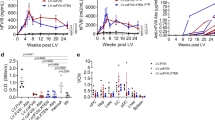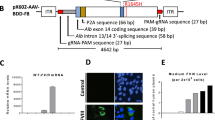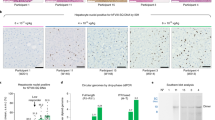Abstract
Hemophilia B, a hereditary bleeding disorder caused by a deficiency of coagulation factor IX (FIX), is an excellent candidate for gene therapy. However, to date, success in hemophilia gene therapy clinical trials has been limited due to failure to achieve or sustain therapeutic levels of factor expression. The phiC31 integrase system efficiently integrates plasmid DNA carrying a transgene and an attB site into a limited number of endogenous pseudo attP sites in mammalian genomes, leading to robust, sustained transgene expression. A strategy utilizing plasmid DNA integrated with phiC31 integrase may offer a facile and safe alternative for sustained human FIX (hFIX) expression. Hydrodynamic tail vein injection was used for delivery of plasmids encoding phiC31 integrase and hFIX to the liver of FIX knockout mice. We demonstrated prolonged therapeutic levels of hFIX in this knockout mouse model of hemophilia B over a 6-month time course when phiC31 integrase was used. Additionally, we observed sustained FIX activity in plasma and phenotypic correction of bleeding after tail clip in phiC31-treated mice. In the livers that received integrase, we also demonstrated prolonged hFIX expression in hepatocytes by immunohistochemistry and documented sequence-specific genomic integration of the hFIX plasmid. These studies suggest the possibility that a similar approach in large animals and humans could lead to a simple and successful gene therapy for hemophilia.
This is a preview of subscription content, access via your institution
Access options
Subscribe to this journal
Receive 12 print issues and online access
$259.00 per year
only $21.58 per issue
Buy this article
- Purchase on Springer Link
- Instant access to full article PDF
Prices may be subject to local taxes which are calculated during checkout





Similar content being viewed by others
References
Tuddenham E, Cooper D . The von Willebrand factor and von Willebrand disease. In: Tuddenham E, Cooper D (eds). The Molecular Genetics of Haemostasis and Its Inherited Disorders. Oxford University Press: Oxford, 1994, pp 374–401.
Soucie JM, Evatt B, Jackson D . Occurrence of hemophilia in the United States. The Hemophilia Surveillance System Project Investigators. Am J Hematol 1998; 59: 288–294.
Lin Y, Chang L, Solovey A, Healey JF, Lollar P, Hebbel RP . Use of blood outgrowth endothelial cells for gene therapy for hemophilia A. Blood 2002; 99: 457–462.
Lin HF, Maeda N, Smithies O, Straight DL, Stafford DW . A coagulation factor IX-deficient mouse model for human hemophilia B. Blood 1997; 90: 3962–3966.
Jin DY, Zhang TP, Gui T, Stafford DW, Monahan PE . Creation of a mouse expressing defective human factor IX. Blood 2004; 104: 1733–1739.
Evans JP, Brinkhous KM, Brayer GD, Reisner HM, High KA . Canine hemophilia B resulting from a point mutation with unusual consequences. Proc Natl Acad Sci USA 1989; 86: 10095–10099.
Lozier JN, Metzger ME, Donahue RE, Morgan RA . The rhesus macaque as an animal model for hemophilia B gene therapy. Blood 1999; 93: 1875–1881.
Herzog RW, Yang EY, Couto LB, Hagstrom JN, Elwell D, Fields PA et al. Long-term correction of canine hemophilia B be gene transfer of blood coagulation factor IX mediated by adeno-associated viral vector. Nat Med 1999; 5: 56–63.
Murphy SL, High KA . Gene therapy for hemophilia. Br J Haematol 2008; 140: 479–487.
Viiala NO, Larsen SR, Rasko JE . Gene therapy for hemophilia: clinical trials and technical tribulations. Semin Thromb Hemost 2009; 35: 81–92.
Mingozzi F, High KA . Immune responses to AAV in clinical trials. Curr Gene Ther 2007; 7: 316–324.
Roth DA, Tawa Jr NE, O’Brien JM, Treco DA, Selden RF . Nonviral transfer of the gene encoding coagulation factor VIII in patients with severe hemophilia A. N Engl J Med 2001; 344: 1735–1742.
Thorpe HM, Smith MC . In vitro site-specific integration of bacteriophage DNA catalyzed by a recombinase of the resolvase/invertase family. Proc Natl Acad Sci USA 1998; 95: 5505–5510.
Groth AC, Olivares EC, Thyagarajan B, Calos MP . A phage integrase directs efficient site-specific integration in human cells. Proc Natl Acad Sci USA 2000; 97: 5995–6000.
Thyagarajan B, Olivares EC, Hollis RP, Ginsburg DS, Calos MP . Site-specific genomic integration in mammalian cells mediated by phage φC31 integrase. Mol Cell Biol 2001; 21: 3926–3934.
Chalberg TW, Portlock JL, Olivares EC, Thyagarajan B, Kirby PJ, Hillman RT et al. Integration specificity of phage φC31 integrase in the human genome. J Mol Biol 2006; 357: 28–48.
Woodard LE, Keravala A, Jung WE, Wapinski O, Yang Q, Felsher DW et al. Evaluating the cancer risk of hydrodynamic injection and phiC31 integrase in a mouse model of MYC-induced hepatocellular carcinoma. PLoS ONE 2010; 5: e11367.
Venken K, He Y, Hoskins RA, Bellen HJ . P[acman]: A BAC transgenic platform for targeted insertion of large DNA fragments in D. melanogaster. Science 2006; 314: 1747–1751.
Calos MP . The phiC31 integrase system for gene therapy. Curr Gene Ther 2006; 6: 633–645.
Liu F, Song YK, Liu D . Hydrodynamics-based transfection in animals by systemic administration of plasmid DNA. Gene Therapy 1999; 6: 1258–1266.
Zhang G, Budker V, Wolff JA . High levels of foreign gene expression in hepatocytes after tail vein injections of naked plasmid DNA. Hum Gene Ther 1999; 10: 1735–1737.
Olivares EC, Hollis RP, Chalberg TW, Meuse L, Kay MA, Calos MP . Site-specific genomic integration produces therapeutic factor IX levels in mice. Nat Biotechnol 2002; 20: 1124–1128.
Keravala A, Lee S, Thyagarajan B, Olivares EC, Gabrovsky VE, Woodard LE et al. Mutational derivatives of phiC31 integrase with increased efficiency and specificity. Mol Ther 2009; 17: 112–120.
Ma CH, Zhang Y, Wang XY, Gao LF, Liu H, Guo C et al. Human endostatin gene transfer, either naked or with liposome, has the same inhibitory effect on growth of mouse liver tumor cells in vivo. World J Gastroenterol 2004; 10: 2874–2877.
Miao CH, Ohashi K, Patijn GA, Meuse L, Ye X, Thompson AR et al. Inclusion of the hepatic locus control region, an intron, and untranslated region increases and stabilizes hepatic factor IX gene expression in vivo but not in vitro. Mol Ther 2000; 1: 522–532.
Nathwani AC, Gray JT, Ng CY, Zhou J, Spence Y, Waddington SN et al. Self-complementary adeno-associated virus vectors containing a novel liver-specific human factor IX expression cassette enable highly efficient transduction of murine and nonhuman primate liver. Blood 2006; 107: 2653–2661.
Wu Z, Sun J, Zhang T, Yin C, Yin F, Van Dyke T et al. Optimization of self-complementary AAV vectors for liver-directed expression results in sustained correction of hemophilia B at low vector dose. Mol Ther 2008; 16: 280–289.
Dejana E, Callioni A, Quintana A, de Gaetano G . Bleeding time in laboratory animals. II—a comparison of different assay conditions in rats. Thromb Res 1979; 15: 191–197.
Broze Jr GJ, Yin ZF, Lasky N . A tail vein bleeding time model and delayed bleeding in hemophiliac mice. Thromb Haemost 2001; 85: 747–748.
Gui T, Reheman A, Ni H, Gross PL, Yin F, Monroe D et al. Abnormal hemostasis in a knock-in mouse carrying a variant of factor IX with impaired binding to collagen type IV. J Thromb Haemost 2009; 7: 1843–1851.
Borchgrevink CF, Waaler BA . The secondary bleeding time; a new method for the differentiation of hemorrhagic diseases. Acta Med Scand 1958; 162: 361–374.
Tomokiyo K, Nakatomi Y, Araki T, Teshima K, Nakano H, Nakagaki T et al. A novel therapeutic approach combining human plasma-derived Factors VIIa and X for haemophiliacs with inhibitors: evidence of a higher thrombin generation rate in vitro and more sustained haemostatic activity in vivo than obtained with Factor VIIa alone. Vox San 2003; 85: 290–299.
Chavez CL, Keravala AK, Woodard LE, Hillman RT, Stowe TR, Chu J et al. Kinetics and longevity of phiC31 integrase in mouse liver and cultured cells. Hum Gene Ther 2010; 21: 1287–1297.
Held PK, Olivares EC, Aguilar CP, Finegold M, Calos MP, Grompe M . In vivo correction of murine hereditary tyrosinemia type I by phiC31 integrase-mediated gene delivery. Mol Ther 2005; 11: 399–408.
Kung SH, Hagstrom JN, Cass D, Tai SJ, Lin HF, Stafford DW et al. Human factor IX corrects the bleeding diathesis of mice with hemophilia B. Blood 1998; 91: 784–790.
Hedner U, Davie EW . Introduction to homeostasis and the vitamin K dependent coagulation factors. In: Scriver C, Beaudet AL, Sly WS, Valle D (eds). The Metabolic Basis of Inherited Diseases. McGraw Hill: New York, 1989, Vol. 2. pp 2107–2134.
Alino SF, Herrero MJ, Noguera I, Dasi F, Sanchez M . Pig liver gene therapy by noninvasive interventionist catheterism. Gene Therapy 2007; 14: 334–343.
Khorsandi SE, Bachellier P, Weber JC, Greget M, Jaeck D, Zacharoulis D et al. Minimally invasive and selective hydrodynamic gene therapy of liver segments in the pig and human. Cancer Gene Ther 2008; 15: 225–230.
Suda T, Kamimura K, Kubota T, Tamura Y, Igarashi M, Kawai H et al. Progress toward liver-based gene therapy. Hepatol Res 2009; 39: 325–340.
Kanimura K, Suda T, Xu W, Zhang G, Liu D . Image-guided, lobe-specific hydrodynamic gene delivery to swine liver. Mol Ther 2009; 17: 491–499.
Acknowledgements
We would like to thank Kristen Newburn for assistance with blood draws and Dr Mark A Kay for providing mating pairs of FIX−/− mice. We are also very grateful to Alfonso Farruggio for help with plasmid constructions. This work was supported in part by NIH grant HL68012 to MPC. LEW was funded by PHS grant CA09302, awarded by the National Cancer Institute, DHHS. GH and PEM received support from the Hemophilia and Thrombosis Research Society and from Homecare for the Cure.
Author information
Authors and Affiliations
Corresponding author
Ethics declarations
Competing interests
MPC is an inventor on Stanford-owned patents covering φC31 integrase.
Rights and permissions
About this article
Cite this article
Keravala, A., Chavez, C., Hu, G. et al. Long-term phenotypic correction in factor IX knockout mice by using phiC31 integrase-mediated gene therapy. Gene Ther 18, 842–848 (2011). https://doi.org/10.1038/gt.2011.31
Received:
Revised:
Accepted:
Published:
Issue Date:
DOI: https://doi.org/10.1038/gt.2011.31
Keywords
This article is cited by
-
Global mapping of binding sites for phic31 integrase in transgenic maden-darby bovine kidney cells using ChIP-seq
Hereditas (2019)
-
Ultrasound-targeted hepatic delivery of factor IX in hemophiliac mice
Gene Therapy (2016)
-
Long-term and efficient expression of human β-globin gene in a hematopoietic cell line using a new site-specific integrating non-viral system
Gene Therapy (2015)
-
Intragenic integration in DLC1 sustains factor VIII expression in primary human cells without insertional oncogenicity
Gene Therapy (2014)
-
Bacteriophage recombination systems and biotechnical applications
Applied Microbiology and Biotechnology (2014)



